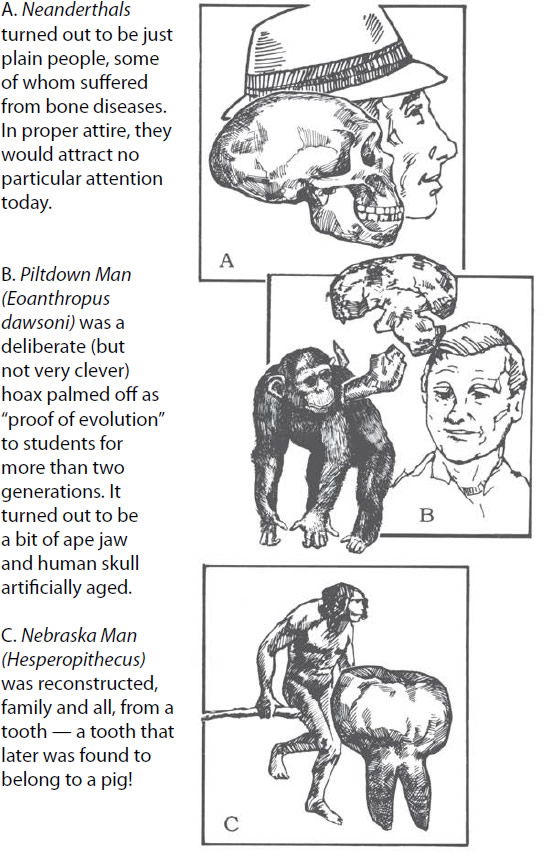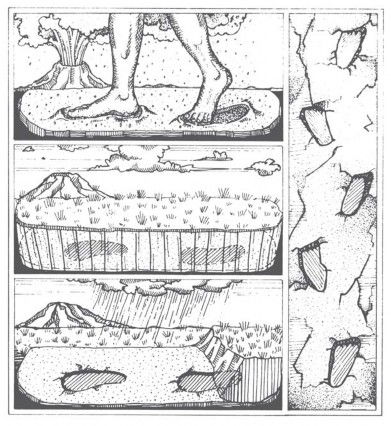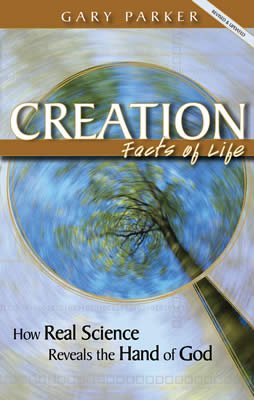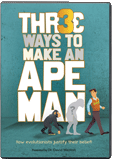
3.6 Human Beings
The Fossil Evidence
What about ourselves? What can we infer from the fossil evidence regarding the origin of human beings? Evolutionists now give us two choices. Either human beings are the result of time, chance, struggle, and death, or else we began as “a hopeful monster whose star was a bit more benevolent than most.”1 According to creationists, the evidence suggests, instead, that we are here by the plan, purpose, and special creative acts of God.
I was part of a television program on creation-evolution produced by the secular Canadian Broadcasting Corporation (CBC).2 The program opened with a medieval princess wandering in a castle garden, apparently looking for something. Then the camera panned over to a rock ledge around a pond. There it was, big bulging eyes and all: a frog. Right before our incredulous eyes, the princess leaned over and kissed the frog. Stars sparkled across the TV screen, then a handsome prince appeared. As the prince and princess embraced, the narrator stepped into the scene with this introduction: If you believe a frog turns into a prince instantly, that’s a fairy tale; if you believe a frog turns into a prince in 300 million years, that’s evolution.
When I believed and taught evolution, I would not have put it that way, of course. As I look back, I realize that story reflects what I really was teaching. According to evolution, if you simply wait long enough, time, chance, struggle, and death (mutation and selection) will gradually turn some amphibians, like that frog, into reptiles, mammals, apes, and finally man, like that prince. Clearly the burden of proof lies with the evolutionist to find a series of fossils suggesting the change from frog to prince, or at least ape to man.

Figure 27. Horse fossils were once thought to illustrate the two parts of an evolutionary series [left]: (1) morphological series, graded structures from many to one hoof per foot, short to long face, small to large size, and browsing to grazing teeth; (2) stratigraphic series [right] from lower to higher in the geologic column diagram.
However, (a) the animal at the bottom is a hyrax (the biblical coney) which seems to have “multiplied after kind”; (b) the size range is less than the variation within kind from miniatures to Clydesdales; (c) fossils once thought to be different stages of evolution are found buried together; and (d) South American fossils reverse the sequence, having large grassland grazers with one hoof on the bottom and small forest browsers with multiple hooves on top. The series, therefore, may be ecological, not evolutionary.
The first fossils proposed as links between apes and mankind were the “cave men” called Neanderthals. The Neanderthal was originally portrayed as a “beetle-browed, barrel-chested, bow-legged brute” (a suitable ancestor for a mugger, if nothing else!). The creationists in those days responded, “Hey, wait a minute. Neanderthals are just plain people, some of whom suffered bone diseases.” The first Neanderthals discovered came from harsh inland environments in Europe, where they could easily have suffered skeletal abnormalities, especially from lack of seafood with iodine in the diet and from shortage during the long winters of sun-induced vitamin D necessary for calcium absorption.
Neanderthals from the Palestine area do not show the more stooped and massive features. The brain volume of Neanderthals is slightly larger than the average brain volume of people today, and brain casts show the Broca’s area involved in the complex speech that so distinctively sets mankind apart from apes. Neanderthal peoples had a well-developed culture, art, and religion. Nowadays, many evolutionists agree completely with creationists: Neanderthals were just plain people, no more different from people living today than one living group is different from another. What were the “cave men”? Just people who lived in caves. (And at today’s housing prices, that may once again be a good idea!)
There was a secular museum in Germany where the curator dressed the wax model of a Neanderthal Man in a business suit and tie. His reason? He said it was time to quit deceiving the public. Neanderthals were just plain people. Indeed, scientists now classify Neanderthals as Homo sapiens, the same scientific name given to you and me.
Tragically, Neanderthals have not been the only people once considered subhuman “missing links.” In an article reprinted in Natural History as part of an issue on the history of evolutionary thought, there’s a short but very sad article by Henry Fairfield Osborn.3 Osborn says that a hypothetical unbiased zoologist from Mars would classify people into several distinct genera and many species. Thus, said Osborn, Negroes would be classified as a separate species, not yet evolved to full human stature. “The standard of intelligence of the average adult Negro,” wrote Osborn as a so-called fact of evolution, “is similar to that of the 11-year-old youth of the species Homo sapiens [which, for Osborn, meant Caucasians only].” Osborn was a leading evolutionist of the 1920s, and it is easy to see how his kind of evolutionary thinking (rejected by modern evolutionists) helped to pave the way for Hitler’s Nazi racism in the 1930s and 1940s. Hitler’s racism fed further on the false sciences of eugenics and “craniometry.”4
The Australian Aborigines were also once treated as subhuman evolutionary links, and were classified as Australian animals by Germany’s leading evolutionist, Ernst Haeckel. The natives of Tasmania were deliberately slaughtered by settlers who justified themselves by saying it was okay to kill wild dogs as farm pests, so why not other non-humans? As her dying wish, the last surviving Tasmanian, Truganini, asked that she be buried with her “people,” not embalmed as a museum specimen. She died, was embalmed, and preserved as an evolutionary link. Warning: Few Christians stood against this horror, perhaps because many churches had already accepted evolution into their thinking. Christians standing on the Bible would have known there’s only one race, the human race, and we’re all parts of it (Acts 17:26).
In 1912, speculation about man’s ancestry shifted to Piltdown Man, dignified by the scientific name Eoanthropus dawsoni. Almost everyone knows that Piltdown Man turned out to be a deliberate hoax, but Piltdown Man wasn’t shown to be a hoax until the 1950s. For over 40 years, the subtle message of the textbooks was clear: You can believe in creation if you want to, but the facts are all on the side of evolution. The facts, in this case, turned out to be a bit of ape jaw and human skull stained to make them look older.
One mystery is who perpetrated the Piltdown hoax, but the real mystery is why did anyone believe it? It was not a particularly clever hoax. When people looked at the teeth with the right hypothesis in mind, “the evidences of artificial abrasion [filing] immediately sprang to the eye. Indeed, so obvious did they seem that it may well be asked—how was it that they had escaped notice before?”5 The age-stain was better done, but the imported mammalian fossils and hand-crafted tools were again obvious frauds. People wanted to believe in evolution, so they were able to see what they wanted to believe (a “people problem” that can only be solved by honestly looking at alternate sides of an issue).
Sometimes people ask me how virtually all the evolutionists in the world could be so wrong about such an important issue as human origins. Answer: it wouldn’t be the first time. Science is a human endeavor, and human beings make mistakes. Evolution goes far beyond the limits of science, and is even more easily influenced by human bias. I can understand that both intellectually and personally since I once accepted the evolutionary bias and its view of the evidence.
The “human factor” in the study of human origins is apparent in the multiple and varied interpretations of Java and Peking Man (“Homo erectus”) recounted in a very readable, yet thoroughly documented, book by Marvin Lubenow, Bones of Contention.6
Joining Neanderthals, Blacks, Aborigines, and Piltdown Man as proposed witnesses for human evolution at the famous Scopes trial7 in 1925 was Nebraska Man. Nebraska Man was dignified by the scientific name Hesperopithecus haroldcookii, but he was never known by anything but a tooth. By imagination, the tooth was put in a skull, the skull was put on a skeleton, and the skeleton was given flesh, hair, and a family! Figure 28 includes a picture of Nebraska Man redrawn from a London newspaper published during the year of the Scopes trial.

Figure 28. A few of the many discarded candidates for man’s ancestor.
Two years later, Nebraska Man was back to being just a tooth. The tooth was found in the real skull, attached to the real skeleton. It turned out not to be the tooth of man’s ape-like ancestor, but the tooth of a pig!
The Australian National Museum in Sydney apparently found a solution to the problem of evolutionary links still missing between apes and man. In June of 1993, we were greeted by a display describing five kinds of apes: lemurs, orangs, gorillas, chimps, and man. No need to look for links between apes and mankind if human beings are still apes! One display described nursing behavior in various apes, including people. Another showed that man and chimps are the only apes that murder their own kind. A third pictured love-making among people and other apes. The text mentioned that some apes were monogamous, others polygamous or promiscuous, and that some men were like gorillas, others like chimps, etc. It was a truly inspiring and edifying display! Most evolutionists, of course, would be just as disgusted by the displays as would anyone else with a respect for science (or for common sense).
Modern speculation on mankind’s ancestry centers on a group of fossils called Australopithecus. In the public mind, these fossils are associated especially with the work in Africa of the Leakey family and of Donald Johanson and his famous specimen, “Lucy” (Figure 29).

Figure 29. Australopithecines, including Johanson’s “Lucy” and the Leakey finds in Africa, are the current candidates for man’s ancestors. Anatomist Charles Oxnard says the fossils “provide a warning against too ready acceptance of this view.” He reaches two conclusions. One is scientific: “If the australopithecines walked upright, it was not in the human manner.” The second is educational: “Be critical.” We must encourage our science students to examine evidence more critically, he says—and that means allowing students to explore evidences for and against both evolution and creation.
The name Australopithecus means “southern ape,” and it seems that apes are just what they are. Johanson likes to point out that where he finds his australopithecine bones, he finds many of the regular African animals (rhinos, boas, hippos, monkeys, etc.), but never apes. Could it be that apes are exactly what he has been finding all along? Lucy’s features are clearly ape-like—except that some claim Lucy and other australopithecines walked upright.
How crucial to the definition of man is relatively upright posture? Vincent Sarich, at the University of California in Berkeley, and Adrienne Zihlman say that if you want something that walks upright, consider the living pygmy chimpanzee or bonobo, Pan paniscus. This rain-forest chimpanzee is only slightly shorter than the average chimpanzee, but it spends a fair amount of time walking upright. (I’ve watched them in the San Diego Zoo.) Since all the other features of the australopithecines are so apelike, perhaps Johanson and the Leakeys have discovered the ancestor of the living pygmy chimpanzee!
Did the australopithecines indeed walk upright? In the American Biology Teacher, eminent anatomist Charles Oxnard8 said:
In one sense you may think there is no problem. For most anthropologists are agreed that the gracile australopithecines . . . are on the main human lineage . . . . This is the view that is presented in almost all textbooks; I expect that it has been your teaching in the classroom; and it is widely broadcast in such publications as the “Time-Life Series” and the beautiful [television] story of “The Ascent of Man.” However, anatomical features in some of these fossils provide a warning against a too-ready acceptance of this story. . . .
As part of his warning, Oxnard reminds his readers of gross errors once made in the cases of Piltdown Man and Nebraska Man.
In a PBS TV program on Lucy,9 Donald Johanson finally contradicted his earlier assertions and admitted that Lucy’s pelvis never really fit with the idea that she walked upright—because the bones of the pelvis fit together too perfectly (something paleontologists usually desire!). So, he shows a scientist sawing up a replica of Lucy’s pelvis and gluing the pieces back together—and then claims the sawed-and-glued pelvis shows Lucy did walk upright after all. I saw the TV program first while speaking on creation in New Zealand. A newsman there commented that Johanson’s standard of evidence might be acceptable in America, but it was not acceptable in New Zealand!
Louis Leakey started the modern interest in australopithecines (and captured the attention of National Geographic) way back in 1959 with his “ape man,” Zinjanthropus. Zinjanthropus has since been reclassified as Austalopithecus bosei or A. robustus, and it is now considered grossly apelike, an extinct ape really not related to man at all.
In fact, it was not the skeletal features that attracted attention to the Leakey finds in the first place. It was tools. As I said at the beginning of this book, every scientist can recognize evidence of creation. Tools imply a toolmaker. Since the tools were found with Australopithecus, Louis Leakey assumed that that creature had made the tools. Thirteen years later, Richard Leakey found beneath the bones his father had unearthed “bones virtually indistinguishable from those of modern man.” Perhaps those tools were used on the owner of the gorilla-like skull, making it more like man’s meal than man’s ancestor. At the time, Richard Leakey said his discovery shattered standard beliefs in evolution.
Actually, fossil discoveries have been shattering standard beliefs in human evolution with monotonous regularity. Each in its day was hailed as “scientific proof” that human beings evolved from ape-like animals, yet all the candidates once proposed as our evolutionary ancestors have been knocked off the list. The cover story in Time magazine for March 14, 1994, assumes that evolution is an absolute fact,10 but it summarizes what is really the evaporating case for human evolution with these dramatic words:
Yet despite more than a century of digging, the fossil record remains maddeningly sparse. With so few clues, even a single bone that doesn’t fit into the picture can upset everything. Virtually every major discovery has put deep cracks in the conventional wisdom and forced scientists to concoct new theories, amid furious debate [emphasis added].
It’s sad that human evolution is still taught as “fact” to school children, college students, and the general public, when “virtually every major discovery” has discredited the so-called evidence and disproved the theory. Even sadder, scientists who know the evidence are “forced to concoct new theories,” but they are only concocting new theories of how human evolution occurred, unwilling to ask whether evolution occurred and to work on the truly new, non-evolutionary theories that the evidence demands. To the creationist, the evidence simply confirms that people have always been people, and apes have always been apes, as far back as the evidence goes (Figure 30).

Figure 30. Footprints are more distinctive of man than most bone fragments are. If the Laetoli footprints above are accepted as human, as discoverer Mary Leakey and other scientists concluded after detailed study, then evolutionists would have to say that people existed “before” mankind’s supposed ancestors. Creationists say that these footprints, and many other evidences, simply suggest that people have always been people, beginning with the first created human beings.
Indeed, secular scientists have discovered molecular evidence that all human beings have descended from one woman and one man, just as the Bible says. The powerhouse organelle in living cells, the mitochondrion, contains its own loop of DNA, and mitochondrial DNA is passed from parents to children only through the mothers’ egg cells. Comparative studies of mitochondrial DNA suggest all human beings had just one mother, whom the media dubbed “Mitochondrial Eve.” In the Bible, Eve is called “the mother of all living” people. Studies of the Y chromosome, which is passed only from fathers to sons, suggests all people had just one father, whom we might call “Y chromosome Adam.”
The first evolutionary estimates for the times of origin, however, showed a 100,000 year difference between the first man and first woman. (Talk about waiting around on a Saturday night for the telephone to ring!) Compromising assumptions were made to put the first man and woman at the same time and place—which God did by creating Adam and Eve on the same day and placing the first couple together in the Garden of Eden (which means Garden of Delight).
The Bible describes Adam and Eve as created mature, ready and able to talk with each other and with God, and to assume stewardship responsibilities for care of the earth. Until the late 1900s, skeptics were inclined to scoff at the idea that Adam, made from dust, could be walking and talking the day of his creation, but now mankind, made in the image of the Creator, has done something nearly as creative. Think about computers. The chips are made primarily of silicon, just “dust of the ground.” When you plug in the computer and hook up the printer and voice synthesizer, what happens? At first, the computer just grunts, but after several weeks, it can utter words, and after a few years full sentences. Of course not! The computer can speak and write, complete with grammar, syntax, and spell-checker, right from the moment it’s created and activated. If mankind, a reflection of the Creator, can program such devices for instant complex functions, how much easier would it be for God to create mature human beings?
Sometimes I like to think we could enter the data regarding human origins into a computer free of human biases and social pressures. I think the computer’s conclusion about human origins would be something like this: “You got here the same way I did. Someone made you with a purpose. By the way, whoever made you did a lot better job than you did making me!”
Creation: Facts of Life
Dr. Parker, a leading creation scientist and former AiG speaker, presents the classic arguments for evolution used in public schools, universities, and the media, and refutes them in an entertaining and easy-to-read style. A must for students and teachers alike! This is a great book to give to a non-Christian as a witnessing tool.
Read OnlineFootnotes
- Adler and Carey, “Is Man a Subtle Accident?”
- Thomas Kelly, producer, Puzzle of the Ancient Wing, Canadian Broadcasting Corporation, “Man Alive” television series (1981).
- Henry Osborn, “The Evolution of Human Races,” Natural History (April, 1980); reprinted from Natural History (January/February 1926).
- Stephen Jay Gould, “The Brain Appraisers,” Science Digest (September 1981).
- Stephen Jay Gould, “Smith Woodward’s Folly,” New Scientist (April 5, 1979).
- Marvin Lubenow, Bones of Contention, revised edition (Grand Rapids, MI: Baker Books, 2004).
- David Menton, Inherit the Wind . . . a Hollywood History of the Scopes Trial (Hebron, KY: Answers in Genesis, 2006).
- Charles E. Oxnard, “Human Fossils: New View of Old Bones,” American Biology Teacher (May 1979).
- PBS, “In Search of Human Origins, Part One,” NOVA series, aired June 3, 1997.
- Michael Lemonick, “How Man Began,” Time, March 14, 1994.
Recommended Resources

Answers in Genesis is an apologetics ministry, dedicated to helping Christians defend their faith and proclaim the good news of Jesus Christ.
- Customer Service 800.778.3390
- © 2024 Answers in Genesis




